Information Processing | Term 2 Chapter 5 | 7th Maths - PascalŌĆÖs Triangle | 7th Maths : Term 2 Unit 5 : Information Processing
Chapter: 7th Maths : Term 2 Unit 5 : Information Processing
PascalŌĆÖs Triangle
PascalŌĆÖs Triangle
The triangle of numbers created by the
famous French Mathematician and philosopher Blaise Pascal
which is named after him as PascalŌĆÖs Triangle. This PascalŌĆÖs Triangle
of numbers provides lot of scope to observe various types of number patterns in it.
Activity
1. Complete the following
PascalŌĆÖs Triangle by observing the number pattern.
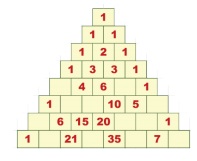
Solution:
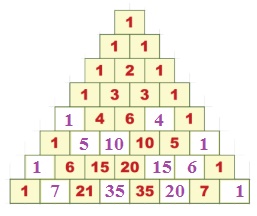
2. Observe the above completed
PascalŌĆÖs Triangle and moving the slanting
strips, find the sequence that you see in it and complete them. One is done for
you
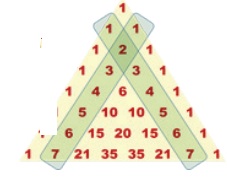
(i) 1, 2, 3, 4, 5, 6, 7.
(ii) 1, 3,
(iii) 1,
(iv)
3. Observe the sequence of numbers obtained in
the 3rd and 4th slanting rows of PascalŌĆÖs Triangle and find the difference between
the consecutive numbers and complete the table given below.
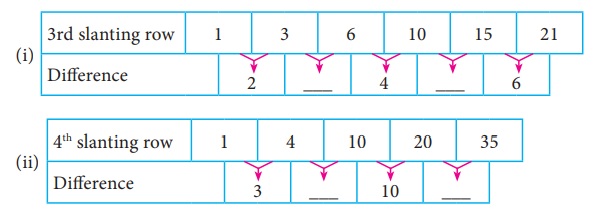
Solution:

Example 5.2
Tabulate the 3rd slanting row of the
PascalŌĆÖs Triangle by taking the position of the numbers in the slanting row as x
and the corresponding values as y.

Verify whether the relationship, y = [ x(x+1) ] /2 between x
and y for the given values is true.
Solution
Observe the table carefully. To verify
the relationship between x and y, let us substitute the values of
x and get the values of y.
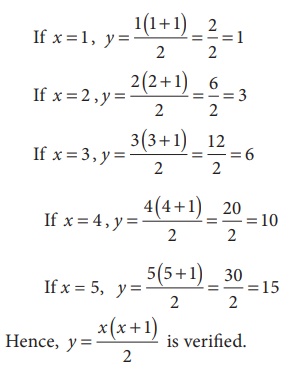
Think
The values of y are obtained by half of the product of
the two consecutive values of x.
Example 5.3
Can
row sum of elements in a PascalŌĆÖs Triangle form a pattern?
Solution
The row sum of elements of a PascalŌĆÖs
Triangle are shown below:

First row = 21ŌłÆ1 =1
Second row = 22-1=2 ├Ś 1=2
Third row =23-1=2 ├Ś 2=4
Fourth row ==24-1=2 ├Ś 2 ├Ś
2=8
Fifth row = 25-1=2 ├Ś 2 ├Ś 2 ├Ś
2=16
Sixth row = 26-1=2 ├Ś 2 ├Ś 2 ├Ś
2 ├Ś 2=32
Seventh row =
27-1=2 ├Ś 2 ├Ś 2 ├Ś 2 ├Ś 2 ├Ś 2=64
Eighth row = 28-1=2 ├Ś 2 ├Ś 2 ├Ś
2 ├Ś 2 ├Ś 2 ├Ś 2=128
Here x denotes the row and y
denotes the corresponding row sum. The values of x and y can be tabulated
as follows:

The relationship between x and
y is y = 2xŌĆō1.
DO YOU KNOW
Observe the pattern obtained
by adding the elements in the slanting rows of the PascalŌĆÖs Triangle.
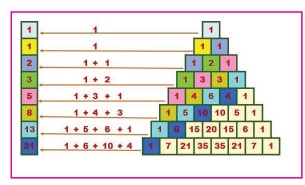
The sequence obtained is
known as Fibonacci
sequence.
Try these
1. Observe the pattern
of numbers given in the slanting rows earlier and complete the PascalŌĆÖs Triangle.
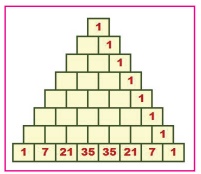
Solution :
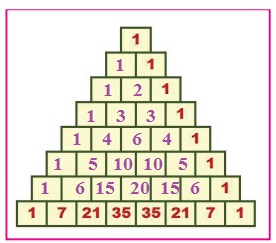
2. Complete the given PascalŌĆÖs
Triangle. Find the common property of the numbers filled by you. Can you relate
this pattern with the pattern discussed in situation 2. Discuss.
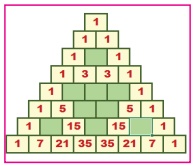
Solution :
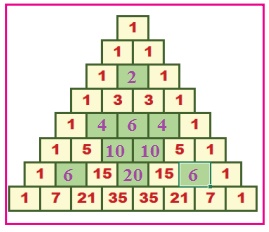
Example 5.4
Observe the numbers in the
hexagonal shape given in the PascalŌĆÖs
Triangle. The product of the alternate three numbers in
the hexagon is equal to the product of remaining three numbers. Verify this
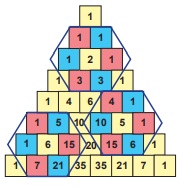

Solution
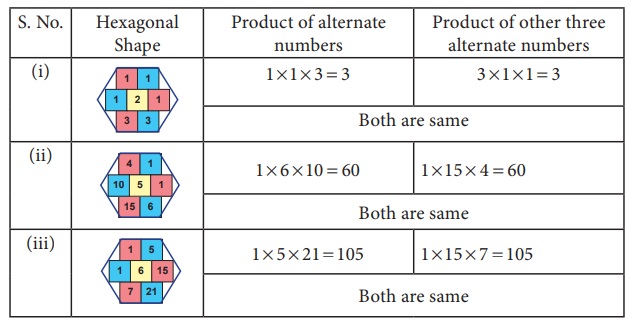
Think
The numbers 1, 3, 6, 10,
... form triangles and are known as triangular numbers. How?
Related Topics